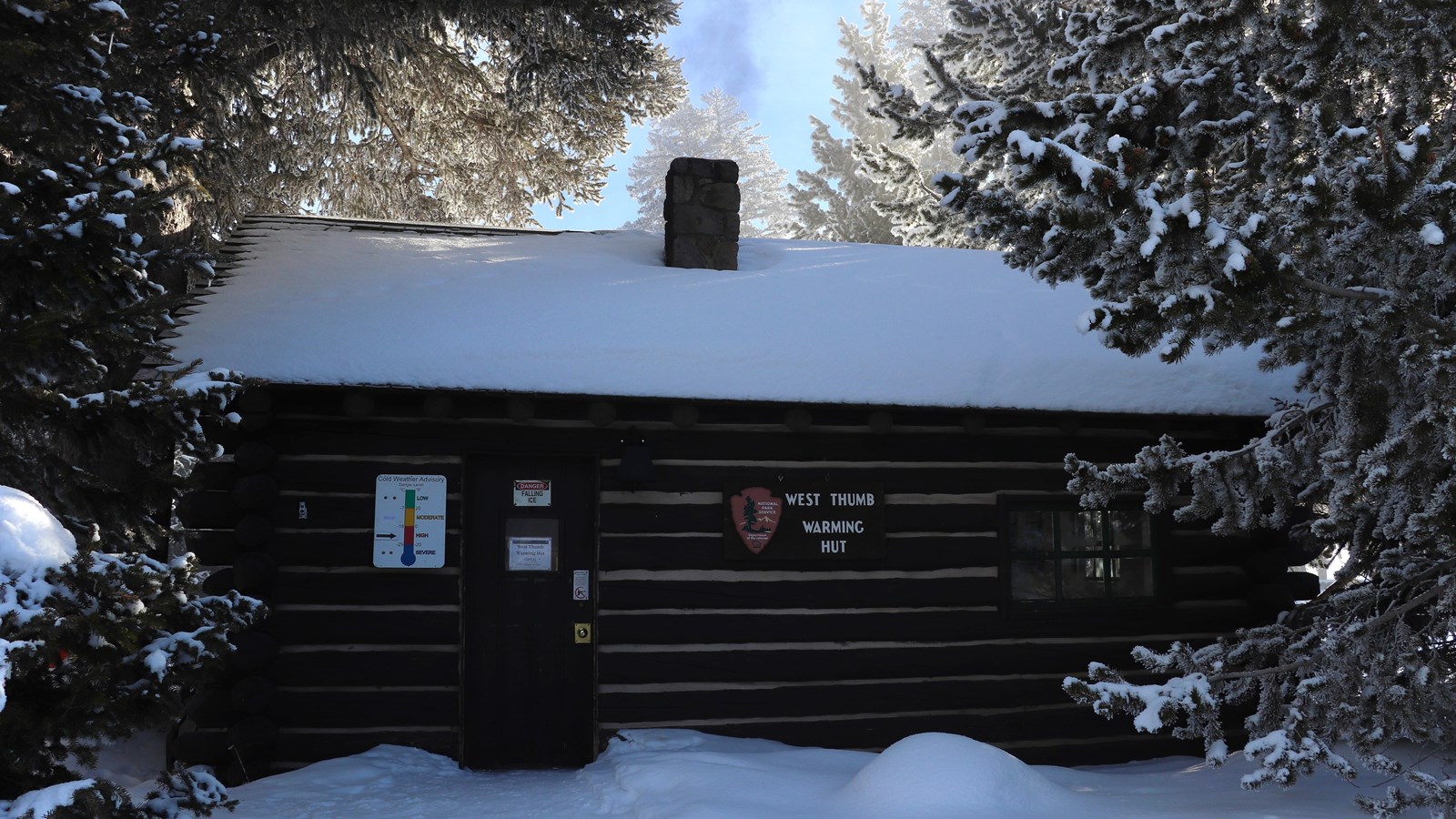Last updated: January 7, 2025
Place
West Thumb Warming Hut

NPS / Addy Falgoust
Restroom
Winter 2024–25
During the winter season, come inside to warm up and get out of the wind and cold. This building doubles as the West Thumb Information Station in the summer. The following amenities are available:
- Staff available: No
- Light Snacks: No
- Water: No
- Restroom: Yes
- Operating Hours: open 24 hours a day, December 15–March 15 (staff present 9 am to 3:00 pm)
Winter Preparedness
Winter is a wonderful time to experience Yellowstone. Before venturing into Yellowstone’s winter wonderland, make sure you have properly planned and are prepared for the challenges brought on by extreme cold and deep snow.
- Let friends or family know your itinerary.
- Do not travel alone.
- Evaluate your party’s and equipment's capabilities.
- Be prepared to make repairs.
- Carry and drink plenty of water, and bring high energy food.
- Be prepared to set up an emergency shelter.
- Bring a first-aid kit, space blanket, extra clothing, and headlamp.
- Carry and know how to use a map and compass.
- Use sunglasses or ski goggles and sunscreen.
Clothing and Gear
Even in severe winter temperatures, you can be comfortable and safe if you dress properly to prevent chilling and overheating. Wear clothes in several adjustable layers:
- Windproof, hooded outer layer
- Wool or other insulated garments underneath
- Wool or synthetic trousers
- Wool or synthetic long underwear
- Wind or rain pants for warmth on windy days
- Wool socks, gaiters, or overboots
- Wool gloves or mittens with waterproof shells.
Avoid tight-fitting garments as they restrict circulation and increase the possibility of frostbite. Do not wear cotton clothes of any kind, including jeans, sweatshirts, underwear, socks. They retain moisture and put you at risk for hypothermia.
Before you rent or borrow equipment, check for fit and suitability for wilderness use. Essential items for snowmobiling include a helmet, face mask, heavily insulated gloves or mittens, felt-lined boots, and a heavily insulated snowmobile suit. Choose skis and boots made for touring or mountaineering. Narrow racing skis may not give you enough surface area to break trail and low shoes may not have enough ankle support. On day trips, consider taking extra clothing, water, and food; matches or a lighter; a map and compass; and a ski repair kit. If you are planning an overnight ski trip, you must obtain a backcountry permit. In addition to the items you would include for a day trip, or an overnight trip in mild weather, you may also want to pack repair parts and tools, a shovel, a winter tent or bivouac bag, and a probe pole and transceiver.
Winter Hazards
Winter provides some different challenges to safely experiencing the wonders of Yellowstone, such as poor weather conditions, avalanches, dangers hidden beneath the snow, and hypothermia.
Here are some ways to mitigate those hazards and stay safe.
- Check weather and avalanche forecasts. High winds and snow can create dangerous whiteout and high avalanche conditions where route finding may become difficult.
- Stay on designated trails in hydrothermal areas. Keep your distance from geysers, hot springs, or mudpots to avoid falling through overhanging snow ledges or thin crust.
- Know how to recognize avalanche terrain and avoid known avalanche paths. Avalanches are more likely to occur during or after heavy fresh snowfall, high winds, or extreme temperature changes.
- Take preventative measures to avoid the dangers of cold weather. Stay dry and learn how to recognize the signs of hypothermia and frostbite—they can set in quickly.
- Bears may be active at any time of year—be alert for signs of bear activity.
Winter Etiquette
- Do not walk on snowshoe or ski trails.
- Snowshoe parallel to the ski track.
- Yield to faster skiers or those going downhill.
- Detour around wildlife—never approach.
- Stay on designated trails and boardwalks.
- Keep children close at hand.
- Be aware of your surroundings at all times.
- Keep your food secure—never feed wildlife.
Snowmobile Regulations
- All snowmobilers must be led by a guide authorized by the National Park Service (NPS) to operate in Yellowstone National Park.
- All snowmobiles must meet NPS sound and emission requirements.
- Snowmobile operators must have a valid state motor vehicle driver’s license in possession. Learner permits are not sufficient.
- Roads are open only 7 am to 9 pm. Snowmobiles are not allowed to operate in the park between 9 pm and 7 am.
- Maximum speed limit is 35 mph for snowmobiles, 25 mph for snowcoaches, or less where posted or as conditions warrant.
- Use hand signals when turning or stopping.
- Allow enough distance between snowmobiles when traveling.
- Pass only when safe.
- If you turn around, stay within the road width.
- Drive in single file, on the right side of the road even if the road is rough.
- When stopping, pull to the far right and park in single file.
- Do not idle your machine more than three minutes.
- Stay on designated roads. Side-hilling, berm-riding, or any off-road travel is prohibited and carries a fine of up to $5,000.
- Report accidents to a ranger.
- Operating a snowmobile while intoxicated is illegal. Possession of open alcoholic beverage containers, including bota bags, is illegal.
Wild animals have the right of way. If bison or other wildlife are on the road, stop at least 25 yards away (100 yards for wolves or bears). Pull your machine as far as possible to the opposite side of the road and give them a chance to move off the road.
